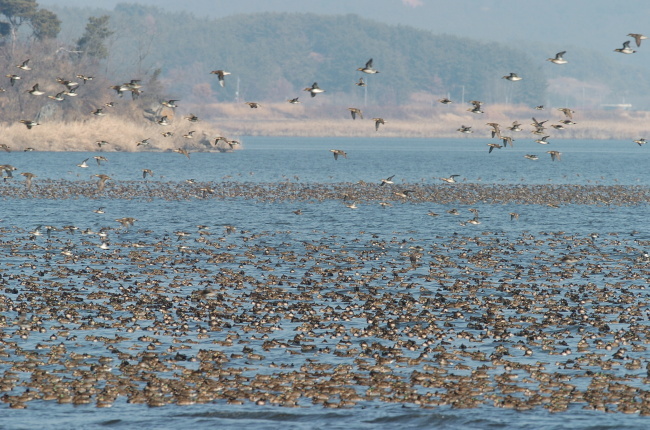Migratory birds visit South Korea from around October as the air begins to grow cool, heralding the change in season.
These winged guests come annually from Russia, China and Mongolia, flying without rest for 15 hours per day to spend a “warmer” winter on the peninsula and nurture new life.
Their arrival here makes winter prime time for bird-watching, with several spots that are especially popular. These sites are usually near river basins and deltas, where rivers meet the sea.
These winged guests come annually from Russia, China and Mongolia, flying without rest for 15 hours per day to spend a “warmer” winter on the peninsula and nurture new life.
Their arrival here makes winter prime time for bird-watching, with several spots that are especially popular. These sites are usually near river basins and deltas, where rivers meet the sea.

However, bird-watchers should be careful not to disturb the sensitive migratory creatures. The Environment Ministry advises observers to keep a distance of at least 30 meters and not disturb nature.
Field glasses or binoculars are commonly used to watch birds, while sudden movements are also discouraged as it can drive them away.
Birds have a wide field of vision, with eyes that can see at least eight to 40 times better than humans, according to the ministry. Therefore, bird-watchers should avoid brightly colored outfits and choose instead to wear green or brown to blend in with their surroundings. Littering and damaging trees or grass in bird-watching areas is also prohibited.
Seocheon County, South Chungcheong Province
One of the biggest sanctuaries is located on the edges of one of the nation’s biggest rivers, the Geumgang, where over 50,000 migratory birds spanning 40 species flock every year. A bird exhibition is located in the center of the county. Water birds, such as whooper swans, spectacled teals and mallards, can be seen in Seocheon County, South Chungcheong Province.
Cheorwon, Gangwon Province
As part of efforts to preserve nature, the Cultural Heritage Administration designated some winter ponds for migratory birds as natural monuments, including in Cheorwon.
It has clear spring water with a temperature of 15 degrees Celsius and basalt ground, providing a warm nesting ground, despite being in a relatively cold region in the north of the country. Egret and critically endangered species such as cranes come and go through the region from October to March. Eagles have also been spotted flying in the area.
Nakdonggang Estuary, South Gyeongsang Province
Another designated natural monument, the Nakdonggang Estuary, is also popular with migratory birds. Wetlands, reed fields and mud flats surround the region, providing abundant food for winged visitors. Snipes and different kinds of plovers flock to the vast region. Furthermore, the waters in the estuary do not freeze due to the relatively warm temperature in winter, which attracts diverse kinds of birds. Some rare white-naped cranes and spoonbills can sometimes be seen.
Geoje Island, South Gyeongsang Province
Rare red-throated divers show up on Geoje Island, while a group of aquatic birds called loons -- another natural monument -- also spend winter there. Some 500 to 1,000 loons pass through the region annually. These loons are of a special kind that can stay underwater for over eight minutes. However, their numbers are decreasing around the world due to excessive poaching. A migratory bird research center, the Korea National Park Institute, is located on the island.
By Jo He-rim / (herim@heraldcorp.com)
Field glasses or binoculars are commonly used to watch birds, while sudden movements are also discouraged as it can drive them away.
Birds have a wide field of vision, with eyes that can see at least eight to 40 times better than humans, according to the ministry. Therefore, bird-watchers should avoid brightly colored outfits and choose instead to wear green or brown to blend in with their surroundings. Littering and damaging trees or grass in bird-watching areas is also prohibited.
Seocheon County, South Chungcheong Province
One of the biggest sanctuaries is located on the edges of one of the nation’s biggest rivers, the Geumgang, where over 50,000 migratory birds spanning 40 species flock every year. A bird exhibition is located in the center of the county. Water birds, such as whooper swans, spectacled teals and mallards, can be seen in Seocheon County, South Chungcheong Province.
Cheorwon, Gangwon Province
As part of efforts to preserve nature, the Cultural Heritage Administration designated some winter ponds for migratory birds as natural monuments, including in Cheorwon.
It has clear spring water with a temperature of 15 degrees Celsius and basalt ground, providing a warm nesting ground, despite being in a relatively cold region in the north of the country. Egret and critically endangered species such as cranes come and go through the region from October to March. Eagles have also been spotted flying in the area.
Nakdonggang Estuary, South Gyeongsang Province
Another designated natural monument, the Nakdonggang Estuary, is also popular with migratory birds. Wetlands, reed fields and mud flats surround the region, providing abundant food for winged visitors. Snipes and different kinds of plovers flock to the vast region. Furthermore, the waters in the estuary do not freeze due to the relatively warm temperature in winter, which attracts diverse kinds of birds. Some rare white-naped cranes and spoonbills can sometimes be seen.
Geoje Island, South Gyeongsang Province
Rare red-throated divers show up on Geoje Island, while a group of aquatic birds called loons -- another natural monument -- also spend winter there. Some 500 to 1,000 loons pass through the region annually. These loons are of a special kind that can stay underwater for over eight minutes. However, their numbers are decreasing around the world due to excessive poaching. A migratory bird research center, the Korea National Park Institute, is located on the island.
By Jo He-rim / (herim@heraldcorp.com)


![[Exclusive] Korean military set to ban iPhones over 'security' concerns](http://res.heraldm.com/phpwas/restmb_idxmake.php?idx=644&simg=/content/image/2024/04/23/20240423050599_0.jpg&u=20240423183955)




![[Herald Interview] 'Amid aging population, Korea to invite more young professionals from overseas'](http://res.heraldm.com/phpwas/restmb_idxmake.php?idx=644&simg=/content/image/2024/04/24/20240424050844_0.jpg&u=20240424200058)

![[Pressure points] Leggings in public: Fashion statement or social faux pas?](http://res.heraldm.com/phpwas/restmb_idxmake.php?idx=644&simg=/content/image/2024/04/23/20240423050669_0.jpg&u=)









